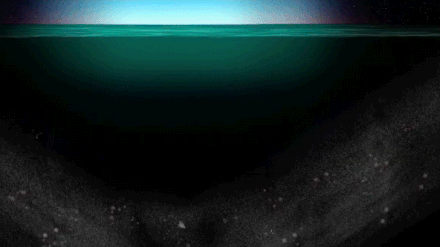
and the ocean surface – animation by NASA [1]
Diel vertical migration (DVM), also known as diurnal vertical migration, is a pattern of movement used by some organisms, such as copepods, living in the ocean and in lakes. The adjective "diel" (IPA: /ˈdaɪ.əl/, /ˈdiː.əl/) comes from Latin: diēs, lit. 'day', and refers to a 24-hour period. The migration occurs when organisms move up to the uppermost layer of the water at night and return to the bottom of the daylight zone of the oceans or to the dense, bottom layer of lakes during the day.[2] DVM is important to the functioning of deep-sea food webs and the biologically-driven sequestration of carbon.[3]
In terms of biomass, DVM is the largest synchronous migration in the world.[4][2] It is not restricted to any one taxon, as examples are known from crustaceans (copepods),[5] molluscs (squid),[6] and ray-finned fishes (trout).[7]
The phenomenon may be advantageous for a number of reasons, most typically to access food and to avoid predators.[8] It is triggered by various stimuli, the most prominent being changes in light-intensity,[8] though evidence suggests that biological clocks are an underlying stimulus as well.[9] While this mass migration is generally nocturnal, with the animals ascending from the depths at nightfall and descending at sunrise, the timing can alter in response to the different cues and stimuli that trigger it. Some unusual events impact vertical migration: DVM can be absent during the midnight sun in Arctic regions[10][11] and vertical migration can occur suddenly during a solar eclipse.[12] The phenomenon also demonstrates cloud-driven variations.[13]
The common swift is an exception among birds in that it ascends and descends into high altitudes at dusk and dawn, similar to the vertical migration of aquatic lifeforms.
- ^ This twilight zone is dark, watery, and yes, also full of intrigue NASA Blog, 21 August 2018.
- ^ a b "Diel Vertical Migration (DVM)". 2011-08-24. Retrieved 5 April 2012.
- ^ Drazen, Jeffrey C.; Sutton, Tracey T. (3 January 2017). "Dining in the Deep: The Feeding Ecology of Deep-Sea Fishes". Annual Review of Marine Science. 9 (1): 337–366. Bibcode:2017ARMS....9..337D. doi:10.1146/annurev-marine-010816-060543. ISSN 1941-1405. PMID 27814034.
- ^ Seo, Hannah (3 December 2021). "The ups and downs of a great vertical migration". Knowable Magazine. doi:10.1146/knowable-110421-1. Retrieved 11 December 2021.
- ^ P.B. Holliland, I. Ahlbeck, E. Westlund, S. Hansson (April 2012). "Ontogenetic and seasonal changes in diel vertical migration amplitude of the calanoid copepods Eurytemora affinis and Acartia spp. in a coastal area of the northern Baltic proper". Journal of Plankton Research. 34 (4): 298–307. doi:10.1093/plankt/fbs001.
{{cite journal}}: CS1 maint: multiple names: authors list (link) - ^ R. Rosa, B.A. Seibel (July–August 2010). "Metabolic physiology of the Humboldt squid, Dosidicus gigas: Implications for vertical migration in a pronounced oxygen minimum zone". Progress in Oceanography. 86 (1–2): 72–80. Bibcode:2010PrOce..86...72R. doi:10.1016/j.pocean.2010.04.004.
- ^ L.F.G. Gutowsky, P.M. Harrison, E.G. Martins, A. Leake, D.A. Patterson, M. Power, S.J. Cooke (August 2013). "Diel vertical migration hypotheses explain size-dependent behaviour in freshwater piscivore". Animal Behaviour. 86 (2): 365–373. doi:10.1016/j.anbehav.2013.05.027. S2CID 49544030.
{{cite journal}}: CS1 maint: multiple names: authors list (link) - ^ a b B. Cisewski, V.H. Strass, M. Rhein, S. Kragefsky (January 2010). "Seasonal variation of diel vertical migration of zooplankton from ADCP backscatter time series data in the Lazarev Sea, Antarctica" (PDF). Deep Sea Research Part I: Oceanographic Research Papers. 57 (1): 78–94. Bibcode:2010DSRI...57...78C. doi:10.1016/j.dsr.2009.10.005.
{{cite journal}}: CS1 maint: multiple names: authors list (link) - ^ N.S. Hafker, B. Meyer, K.S. Last, D.W. Pond, L. Huppe, M. Taschke (July 2017). "Circadian clock involvement in zooplankton diel vertical migration". Current Biology. 27 (14): 2194–2201. doi:10.1016/j.cub.2017.06.025. hdl:1893/28564. PMID 28712565.
{{cite journal}}: CS1 maint: multiple names: authors list (link) - ^ Darnis, G.; Hobbs, L.; Geoffroy, M.; Grenvald, J. C.; Renaud, P. E.; Berge, J.; Cottier, F.; Kristiansen, S.; Daase, M.; Søreide, J. E.; Wold, A.; Morata, N.; Gabrielsen, T. (2017). "From polar night to midnight sun: Diel vertical migration, metabolism and biogeochemical role of zooplankton in a high Arctic fjord (Kongsfjorden, Svalbard)". Limnology and Oceanography. 62 (4): 1586–1605. Bibcode:2017LimOc..62.1586D. doi:10.1002/lno.10519. hdl:10037/11981. ISSN 1939-5590. S2CID 56252159.
- ^ C. Manno, A.K. Pavlov (January 2014). "Living planktonic foraminifera in the Fram Strait (Arctic): absence of diel vertical migration during the midnight sun". Hydrobiologia. 721: 285–295. doi:10.1007/s10750-013-1669-4. S2CID 18320084.
- ^ K. Sherman, K.A. Honey (May 1970). "Vertical movements of zooplankton during a solar eclipse". Nature. 227 (5263): 1156–1158. Bibcode:1970Natur.227.1156S. doi:10.1038/2271156a0. PMID 5451119. S2CID 4209244.
- ^ Omand, Melissa M.; Steinberg, Deborah K.; Stamieszkin, Karen (10 August 2021). "Cloud shadows drive vertical migrations of deep-dwelling marine life". Proceedings of the National Academy of Sciences. 118 (32): e2022977118. Bibcode:2021PNAS..11822977O. doi:10.1073/pnas.2022977118. ISSN 0027-8424. PMC 8364114. PMID 34349017.